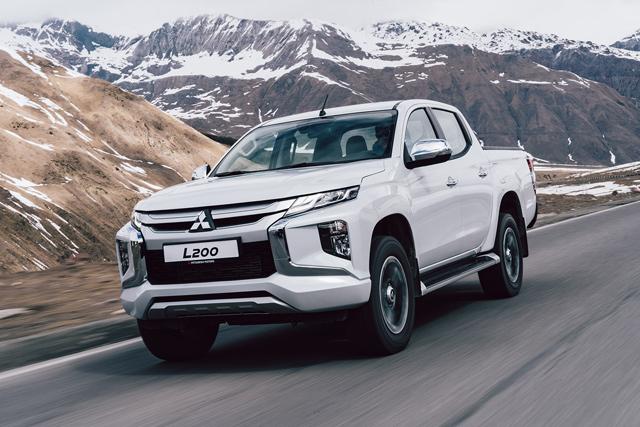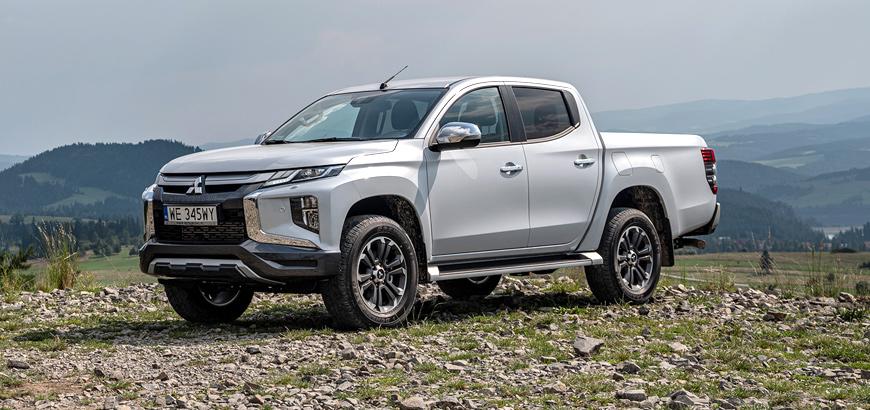You are here
Mitsubishi L200 2.4 MPI Double Cab 4WD: Ruggedly radical redesign
By Ghaith Madadha - Aug 10,2020 - Last updated at Aug 10,2020

Photo courtesy of Mitsubishi
One of the more popular pick-ups in the compact pick-up segment, which accounts for some 90 per cent of Middle East truck sales, the Mitsubishi L200 has until now been one of the more discretely styled, yet, better-selling among its peers. But, with a new design language being adopted across most of the Japanese manufacturer’s ever-more crossover SUV-focused line-up, the understated but tough, dependable and affordable L200 workhorse now receives a radically re-imagined aesthetic refresh that brings it into line with other Mitsubishi models.
Aggressive aesthetic
First introduced in 2019 and winner of the 2020 Middle East Car of the Year awards’ best Midsize Truck category in which it competed against the Ford Ranger and Toyota Hilux, the L200 is available in a choice of turbo-diesel and petrol engines and in different cabin and drive-line choices. The sort of mixed use work and private use truck that is increasingly popular in many parts of the region, the L200 range available in the Middle East omits some of the more powerful turbo-diesel versions available globally, and instead focuses on a more affordable and slightly more work-oriented line-up.
In essence a major design face-lift of the fifth generation L200 that first entered service in 2015, the new L200 is certainly a bolder, chunkier and more rugged looking design with its brutishly aggressive new “Dynamic Shield” corporate face. Superseding its predecessor’s rakishly angled fascia and lower set bonnet edges that made road visibility so great, the new L200 instead opts for a hyper-assertive new look sure to draw attention even among the most rugged looking of competitors, and also includes new more angular wheel-arches in place of the outgoing model’s rounded arches.
Smooth operator
Comprised of a vast upright assembly of deep-set side lights and a huge air intake flanked by chrome strips, the new L200’s fascia is somewhat akin to a huge bumper with slim, swept back, moody and slitty headlights and grille atop. Dominated by its distinctively different fascia, the new L200 also features more discretely smartened up and refreshed rear lights and other elements, while underneath its now high-rise bonnet, it is powered by a choice of three inline four-cylinder engines, including two differently tuned 2.5-litre turbo-diesels and a single naturally-aspirated 2.4-litre petrol offering, as driven.
A low-revving SOHC unit designed for good low-end torque and easy hauling, towing and off-road driving rather than high speed hijinks, the petrol-powered L200 is a smoother and quieter performer with more progressive delivery and torque and power accumulation than most diesel-powered pick-ups, even if lacking the vast torque output, more potent power and high efficiency of a modern turbo-diesel. That said, its naturally-aspirated petrol design is in long run ownership easier and less costly to maintain, and in this application develops 130BHP at 5,250rpm and 149lb/ft at 4,000rpm, which allows for a 161km/h top speed.
Broad range ability
Accumulative in delivery, the L200 2.4 MPI is responsive from idling, flexible in mid-range, more willing at top-end with a broader rev range than many diesel rivals, if not quite with the same muscular pulling power. Driving the rear wheels under normal driving conditions through a 5-speed manual gearbox with an intuitive clutch biting point and slick and accurate shifts, it is both user-friendly and engaging in its gear lever action. For more demanding off-roading and towing over low traction surfaces, one can engage the L200’s four-wheel-drive mode or low ratio four-wheel-drive for extreme high power crawling conditions.
Timely in its on-road performance and well capable of keeping up with traffic, if not especially quick, the L200 is also a capable off-roader with generous 200mm ground clearance. Meanwhile, 30° approach 24° break-over and 45° side slope off-road angles remain unchanged over its predecessor. But with a slightly longer body length, the new L200’s 22° departure angle is marginally reduced over the pre-facelift model. Best looking with big, wide off-road oriented tyres to fill its big wheel-arches, the driven L200’s more moderate yet durable 205R16C tyres provided good comfort, grip, steering feel and peace of mind.
Agile and comfortable
With rugged ladder frame construction with independent front double wishbone and tough live axle and leaf spring rear suspension, the L200 takes lumps and bumps in its stride, but is slightly bouncy at the rear when unloaded. Slightly narrower and shorter in wheelbase than some competitors, the L200 is agile and manoeuvrable through winding road with its light steering providing good in-class accuracy, feel and eager and alert turn-in. Balanced through corners but with mild lean, the L200 is meanwhile confident and settled on highway, and with good stability, cabin refinement, and responsive braking.
Offering good views and easy to place on road and manoeuvre, despite a higher bonnet line than its predecessor’s lower bonnet and little restricted front visibility, the L200 is meanwhile spacious and comfortable inside, with big side mirrors, easy cabin access, good headroom and a supportive driving position. Controls and layouts are user-friendly and cargo room is generous. Unfussed, but pleasant inside, the L200 features tough hard wearing plastics, trim and fabric upholstery, while there are plenty of creature comforts and safety and convenience features in the better equipped GLX spec version, as tested.
TECHNICAL SPECIFICATIONS
Engine: 2.4-litre, in-line 4-cylinders
Valve-train: SOHC, multi-point injection
Gearbox: 5-speed manual, four-wheel-drive
Driveline: low gear transfer
Power, BHP (PS) [kW]: 130 (132) [97] @5,250rpm
Specific power: 54BHP/litre (approximately)
Power-to-weight: 75.8BHP/tonne
Torque, lb/ft (Nm): 149 (202) @4,000rpm
Specific torque: 62Nm/litre (approximately)
Torque-to-weight: 86.9Nm/tonne
Top speed apprx. 161km/h
Fuel capacity: 75-litres
Length: 5,305mm
Width: 1,815mm
Height: 1,775mm
Wheelbase: 3,000mm
Tread, F/R: 1,520/1,515mm
Overhang, F/R: 880/1,420mm
Minimum ground clearance: 200mm
Loading floor height: 845mm
Cargo bed length/width/height: 1,520/1,470/475mm
Approach angle: 30°
Break-over angle: 24°
Departure angle: 22°
Side slope angle: 45°
Kerb weight: 1,715kg
Gross vehicle weight: 2,700kg
Suspension, F/R: Double wishbones/live axle, leaf springs
Steering: Power-assisted rack & pinion
Turning circle: 11.8-metres
Brakes, F/R: Ventilated discs/drums
Tyres: 205R16C
Related Articles
Among the most popular player in the popular compact pick-up segment which accounts for some 90 per cent of truck sales in the Middle East,
A long time popular player in the increasingly prolific mixed work, play and daily drive compact pick-up segment that accounts for around 90
Launched in recent weeks and exclusively for Middle East markets, the Ram 1200 line is expected to greatly expand the former Dodge and now s


















